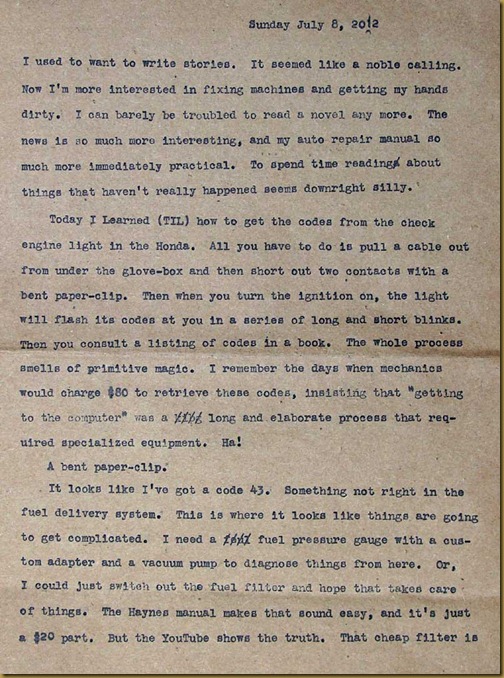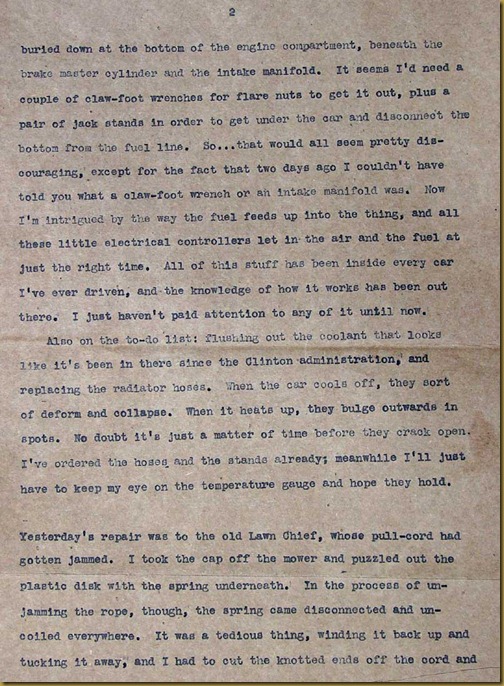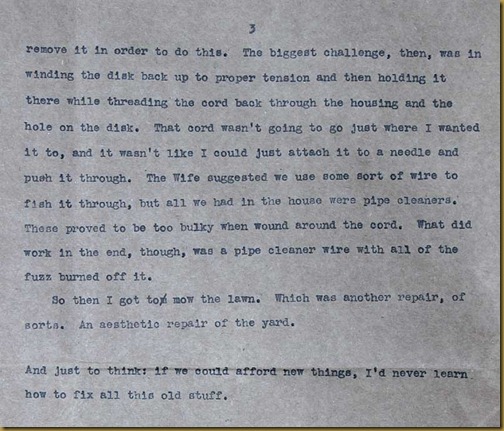One does not simply do something as neurotic and repetitive as converting paper bags into typing paper without developing a few techniques and best practices. As there seems to be some interest from the typosphere in trying out this practice, I thought that I might share a few.
Usually, one of The Wife’s grocery trips will provide more than enough paper to keep me typing for the week. In fact, I have yet to run out of grocery bag paper since she has started saving these bags for me. If I could keep up with her grocery runs, I’d probably have a trilogy completed by the end of the year. In any case, it frees me up to ramble on to no end when I know that at least, the paper was free.
So, to begin:
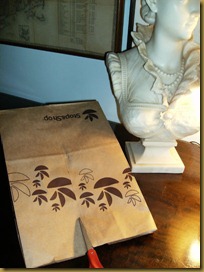
It’s best to make your first cut along the seam, where the two layers of paper are glued together. When I started, I would cut along the corner. But this meant that, when the paper was all laid out, the bulky seam would be stuck in the middle. Typewriters don’t like passing that doubled up layer under their platens.
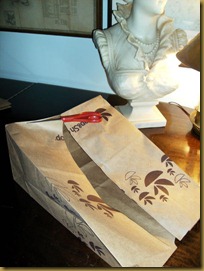 When you get to the bottom, cut around to remove it. It’s easiest if you cut about 1/4” away from the crease. This keeps your scissors from getting caught up in all the layers and glue down there.
When you get to the bottom, cut around to remove it. It’s easiest if you cut about 1/4” away from the crease. This keeps your scissors from getting caught up in all the layers and glue down there.
 Once you’re done with this, you’ll be able to spread out the bag in one giant sheet. Now you can slice off that seam and get rid of it.
Once you’re done with this, you’ll be able to spread out the bag in one giant sheet. Now you can slice off that seam and get rid of it.
 There is very little waste involved in this process, but I’m wracking my brains to come up with a use for the discarded bottoms and seams. Maybe grocery bag bottoms could supplant the Dollar as a new currency, in the thriftier times that may be coming? Perhaps I’ll line my mattress with them…
There is very little waste involved in this process, but I’m wracking my brains to come up with a use for the discarded bottoms and seams. Maybe grocery bag bottoms could supplant the Dollar as a new currency, in the thriftier times that may be coming? Perhaps I’ll line my mattress with them…

Back to the sheet. Fold it in half the long way. Surprise! It’s approximately 8 1/2” wide! At this point, you can use a knife to slit along this length and get two long strips. Paper this size has its uses. It makes for uninterrupted typing—you could even tape a bunch of them together for a Kerouac type scroll or BAROP. It’s also pretty dramatic to start feeding one of these through your machine in a public place.
I tired of these vanity sized strips, however, when it came time to store and file my writing. Long strips don’t fit in a file cabinet too easily, and there’s really nothing useful you can do to them with a three-hole punch. Sure, you can fold and stack the strips, but then unfolding it anytime you want to revise or reference something you wrote last week gets to be a drag pretty quick.
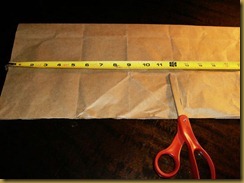 Instead, I cut through the folded-over bag along the seams, located one third and two thirds along its length. This will make three 12” sections with no more waste. That’s close enough to normal for me, but someone with a proper paper cutter could trim off the extra inch later on if they were so inclined. They would probably also use a lot more care in executing straight cuts throughout this process, while I am embracing the absurd rusticity of the whole deal.
Instead, I cut through the folded-over bag along the seams, located one third and two thirds along its length. This will make three 12” sections with no more waste. That’s close enough to normal for me, but someone with a proper paper cutter could trim off the extra inch later on if they were so inclined. They would probably also use a lot more care in executing straight cuts throughout this process, while I am embracing the absurd rusticity of the whole deal.
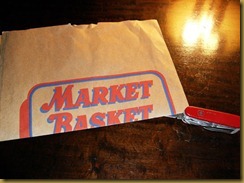
Take the three folded-over sections into a single stack and then slit the fold with a knife. Careful not to cut yourself!
Now you’ll have six sheets at 8 1/2” by 12”.
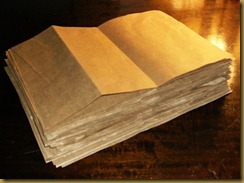
Huzzah! A proper stack of durable, heavy paper.
It’s not lying quite flat enough, though.

A day or two under a stack of books helps take out the creases and compress the paper into something a little more manageable.
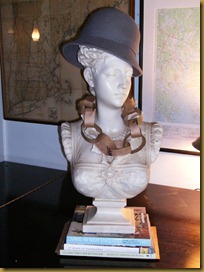
For a little extra weight, enlist the help of a friend.
Oh hey, I found a use for those discarded strips!
 All flattened out and ready for a typecast.
All flattened out and ready for a typecast.
Very nice!
* * *
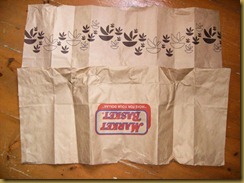 One final observation: you can see here the clear advantage of Market Basket over Stop and Shop grocery bags. Stop and Shop has chosen to spread their marketing around the whole circumference of their bags. This is their prerogative, of course, but it means you’ll only be able to use one side of their paper. (That leaf pattern really is too dark to type legibly across, even with a fresh ribbon.)
One final observation: you can see here the clear advantage of Market Basket over Stop and Shop grocery bags. Stop and Shop has chosen to spread their marketing around the whole circumference of their bags. This is their prerogative, of course, but it means you’ll only be able to use one side of their paper. (That leaf pattern really is too dark to type legibly across, even with a fresh ribbon.)
The Market Basket bag, on the other hand, will provide a sheet that is blank on both sides four out of six times. This strikes me as a very generous design decision on their part. One of the great joys of paper bag typing is that it’s tough enough to use both sides with no punch-through.
I’m toying with the idea of making journals out of this stuff, since it works phenomenally well with fountain pens as well. Moleskine should have started using this years ago. Their journals bleed fountain pen ink something terrible.
In anticipation of this project, I’ve taken to sorting the logo-free sheets from the printed ones. I’ll type on the blank side of the printed ones and fold the virgin pages into a nice journal.
Which probably brings me to a whole new level of crazy.
















